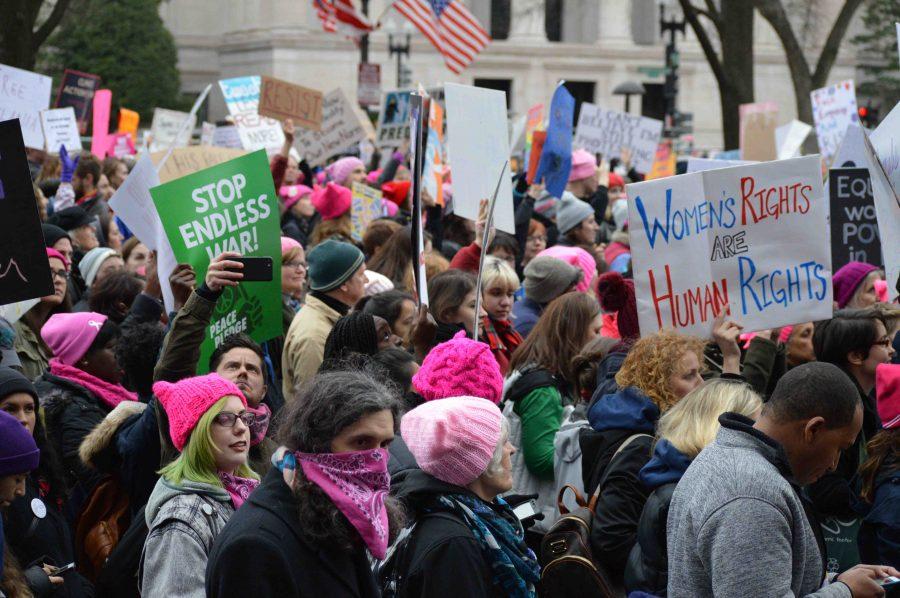(Opinion) Democracy’s response to Trump’s complacency
Women’s March on Washington, sister marches bring millions of people together to advocate for women’s rights
On Jan. 21, 500,000 people in Washington D.C. walked in the Women’s March on Washington, advocating for women’s rights in light of the past election. President Donald Trump’s campaign was focused around starting movements, and this was the first great movement of Trump’s presidency. The Women’s March was not started by Trump, however; it was organized because of him.
In response to controversial remarks the president has made about women, a nonprofit organization created and organized a peaceful protest to advocate for women’s rights, many focusing on the comments that have been said during this campaign season.
According to the Women’s March on Washington’s Facebook page, “This is more than just a single day of action, this is the beginning of a movement to protect, defend and advance human rights, even in the face of adversity.”
In response to this, Trump commented early Sunday morning on the Women’s March that took place the day before.
“Watched protests yesterday but was under the impression that we just had an election! Why didn’t these people vote? Celebs hurt cause badly,” Trump tweeted from his personal Twitter account.
After one of the most controversial and divisive elections in history, it’s important to remember what a democracy is all about. A democracy is a system that is supposed to be in the favor of the people and make sure the citizens’ voices are heard. Citizens under the First Amendment also have the right to a peaceful petition and assembly. People participating in this event exercised their rights, representing themselves in place of the elected official who wouldn’t.
Across the country, there were sister marches in cities like Pittsburgh, Los Angeles, Chicago and New York City. In all, there was an estimated 4.6 million people who took a stand for women’s rights.
On the day of the protest in Washington, D.C., there were 1,001,613 trips on the Metro Transit system, second only to former president Barack Obama’s inauguration in 2009. In comparison, there was a reported 570,557 Metro passengers when Trump was sworn in as president the previous day.
These numbers are important to consider. Whether Trump and his administration realize it or not, more people came to stand against him rather than with him.
He and his administration, based on past promises and policy ideals, might try to silence this progressive movement by saying that it’s time to stand behind our president. It’s not time to stand behind our president until he puts the well-being of the citizens at the top of his priority list.
Currently, according to the Global Economic Forum, the U.S. is ranked 45th in the world when it comes to women’s equality, behind even Cuba and Rwanda. Inequality comes in forms such as the 20 percent wage gap difference between genders, healthcare laws or political empowerment. With today’s resources and advancements, there’s no reason the U.S. shouldn’t be number one on that list.
For the past 100 years, women have been fighting for equal rights. On March 3, 1913, one day before Woodrow Wilson’s inauguration, more than 5,000 women descended to Washington D.C. to fight for the right to vote. Six years later, Congress passed the 19th Amendment.
This march, which is over a century old and considerably much smaller than the most recent march, turned the heads of men who tried to stop them and congress who later complied to them.
Women today face the same issues that these women fought for a century ago. Women still fight against the belief that they don’t need a march to be equal, that women shouldn’t be able to make their own decisions about their own bodies. They still fight against men making decisions for them regarding healthcare, maternity leave or prenatal care. Until women can make their own choices regarding simple rights, they are not “fine.” They are not equal.
These rights for women go beyond politics. These rights don’t stop at the Democratic or Republican Party lines; they are universal. This march was started to peacefully advocate this right. After the reported zero arrests made during this march, it was one of the largest and most peaceful protests in history; making it hard to argue that this movement was anything but peaceful.
As a part of the “10 Actions 100 Days” campaign organized by Women’s March on Washington, send a postcard to your senators to continue standing up for what’s right.



